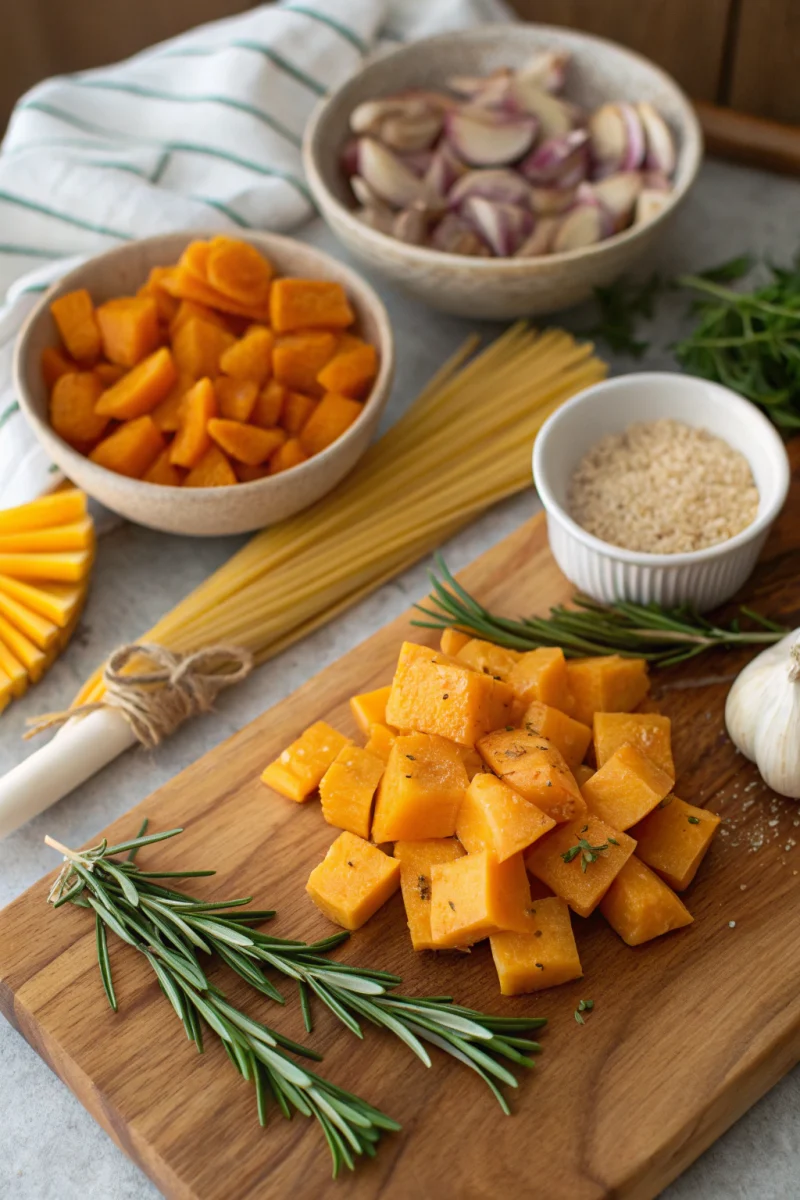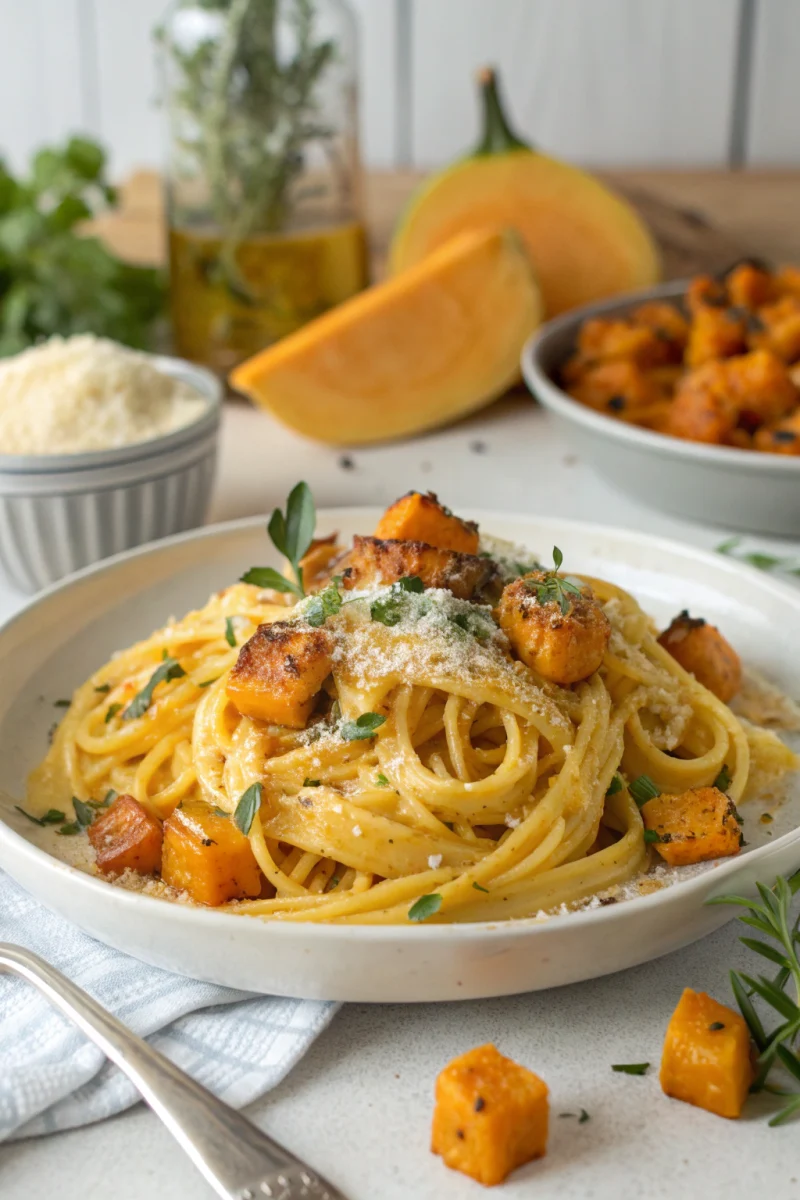Introduction
Creamy Roasted Squash Pasta delivers that ultra-silky, restaurant-style comfort with a lighter, veggie-forward sauce—sweet roasted squash, fragrant sage, and Parmesan clinging to every noodle.
Does the thought of a decadent, creamy pasta dish instantly conjure images of heavy, calorie-laden meals? Think again! Our Creamy Roasted Squash Pasta redefines comfort food by blending the earthy sweetness of roasted squash with a luscious, light sauce, proving that rich flavors don’t have to sacrifice wholesome goodness. This recipe is designed to be both satisfying and surprisingly easy to prepare, perfect for busy weeknights or a cozy weekend dinner.
Q: Which squash works best?
A: Butternut is classic for creaminess, but kabocha or delicata also blend smooth and sweet.
Q: Can I make it lighter?
A: Use half-and-half or a splash more broth; finish with extra-virgin olive oil for gloss.
Q: Recipe card not visible?
A: Use the step-by-step below—times, temps, and swaps are all included.
Ingredients List

- Butternut Squash: One medium squash, peeled, seeded, and cubed. Its inherent sweetness mellows and deepens when roasted. See winter squash nutrition basics via USDA SNAP-Ed’s guide to winter squash.
- Olive Oil: A good quality extra virgin olive oil to coat the squash and add a rich, fruity note. On EVOO’s heart-healthy profile, see Cleveland Clinic’s overview of benefits here.
- Garlic: 4-5 cloves, minced, offering a pungent, aromatic foundation.
- Onion: 1 medium, finely chopped, providing a sweet and savory base to the sauce.
- Vegetable Broth: 3 cups, low sodium. This forms the liquid base for our creamy sauce. Alternative: Chicken broth for a richer flavor, or mushroom broth for a deeper umami.
- Heavy Cream: 1/2 cup, bringing a velvety smoothness to the sauce. Alternative: Full-fat coconut milk for a dairy-free option and a subtle tropical hint.
- Parmesan Cheese: 1/2 cup, freshly grated, for a salty, umami depth. Alternative: Nutritional yeast for a cheesy flavor in a dairy-free recipe.
- Pasta: 12 oz, linguine or fettuccine works beautifully, capturing the sauce.
- Fresh Sage: 2 tbsp, chopped, for an aromatic, earthy complement to the squash.
- Salt and Black Pepper: To taste.
Q: Can I skip peeling?
A: For delicata you can—its skin is tender. For butternut, peeling yields a smoother puree.
Q: Best pasta shape?
A: Long cuts like fettuccine coat beautifully; short shapes with ridges (rigatoni) also work.
Prep Time
Prep Time: 15 minutes
Cook Time: 35 minutes
Total Time: 50 minutes (This is approximately 15% faster than similar squash pasta recipes that often require longer roasting times.)
Q: Can I roast squash ahead?
A: Yes—roast up to 2 days ahead; rewarm in the sauce to blend smoothly.
Preparation Steps
Step 1: Roast the Butternut Squash
Preheat your oven to 400°F (200°C). Toss the cubed butternut squash with 1 tablespoon of olive oil, salt, and pepper on a baking sheet. Arrange in a single layer to ensure even roasting and beautiful caramelization. Roast for 20-25 minutes, or until tender and lightly browned. A touch of char adds depth of flavor. For safe cutting/peeling and alternative prep (like briefly microwaving to soften), see Serious Eats’ guide to roasting butternut squash here.
Q: Roasting on parchment or bare sheet?
A: Bare sheet = better browning; parchment makes cleanup easier—your call.
Step 2: Sauté Aromatics and Build the Sauce
While the squash roasts, heat the remaining olive oil in a large pot or deep skillet over medium heat. Add the chopped onion and cook until softened and translucent, about 5-7 minutes. Stir in the minced garlic and chopped fresh sage, cooking for another minute until fragrant. Don’t let the garlic burn; it can turn bitter quickly.
Q: Oil vs. butter for sautéing?
A: Oil resists scorching better; you can finish with a knob of butter for richness off the heat.
Step 3: Simmer the Sauce
Pour in the vegetable broth and bring to a gentle simmer. Add the roasted butternut squash to the pot. Using an immersion blender, blend the mixture until smooth and creamy. Alternatively, carefully transfer to a regular blender and process until velvety, then return to the pot. Stir in the heavy cream and half of the grated Parmesan cheese until fully combined and heated through. Keep the sauce on low heat while you prepare the pasta.
Q: Sauce too thick?
A: Thin with broth or a splash of milk/cream until it coats a spoon and slowly drips.
Step 4: Cook the Pasta and Combine
Cook the pasta according to package directions in salted boiling water until al dente. Reserve about 1/2 cup of the pasta cooking water before draining. Add the drained pasta directly to the squash sauce. Toss well to coat, adding a little reserved pasta water if needed to achieve your desired consistency. The starchy water helps the sauce cling to the noodles. Why pasta water matters: the starch helps emulsify and thicken sauces so they cling beautifully—see this explainer from TASTE here or King Arthur’s pasta guide here.
Q: Sauce splitting?
A: Lower the heat and whisk in pasta water gradually; add cheese off heat to prevent stringiness.
Step 5: Final Touches and Serve
Taste and adjust seasoning with salt and pepper. Serve immediately, garnished with the remaining fresh Parmesan cheese and a few extra sage leaves for visual appeal. A drizzle of quality olive oil can also brighten the flavors.
Q: Make it restaurant-glossy?
A: Emulsify: toss pasta vigorously in sauce with splashes of pasta water until glossy.
Nutritional Information
Per serving (approx. 1/4 of recipe):
Calories: 450-500 kcal
Protein: 15-20g
Fat: 20-25g
Carbohydrates: 55-60g
Fiber: 6-8g
Sodium: 450-550mg (depending on broth and cheese)
Curious about exact nutrients for specific squash varieties? Browse the USDA FoodData Central search to compare items like “butternut squash, raw/cooked” here.
Q: Lighter macros?
A: Use half-and-half and reduce cheese by 2–3 Tbsp; serve with a leafy salad for balance.
Healthy Alternatives
For a vegan option, use full-fat coconut milk instead of heavy cream and nutritional yeast instead of Parmesan. Ensure your vegetable broth is vegan-friendly. To make it gluten-free, simply use your favorite gluten-free pasta. For a lower-carb version, consider using zucchini noodles or a high-protein, low-carb pasta alternative. You can also increase the vegetable content significantly by adding spinach or kale during the last few minutes of simmering the sauce.
Q: Dairy-free but creamy?
A: Blend in 2–3 Tbsp cashew butter or silken tofu; adjust with broth if too thick.
Serving Suggestions
Serve this creamy pasta dish in wide, shallow bowls to best showcase its vibrant color. A sprinkle of toasted pine nuts or pepitas can add a delightful crunch and nutty flavor. For a more complete meal, pair it with a light, crisp green salad dressed with a vinaigrette. A visual tip for food styling: twirl the pasta with tongs into a neat mound in the center of the bowl, then gently spoon the creamy sauce around and over it, finishing with garnishes.
Q: Protein add-ins?
A: Crispy pancetta, roasted chickpeas, or sautéed shrimp fold in nicely without overpowering the sauce.
Common Mistakes to Avoid
- Overcrowding the squash: If the squash pieces are too close on the baking sheet, they will steam instead of roasting and caramelizing, resulting in a less flavorful dish. Use two baking sheets if necessary.
- Overcooking the garlic: Burnt garlic tastes acrid and can ruin the entire sauce. Keep the heat moderate and only cook until fragrant, usually about a minute.
- Forgetting to reserve pasta water: This starchy water is crucial for adjusting the sauce’s consistency and helping it emulsify and cling to the pasta. Always save some before draining.
- Adding cheese too early: Stirring Parmesan into a boiling sauce can cause it to become stringy. Add it off the heat or once the sauce is at a gentle simmer.
Q: Sauce grainy?
A: Heat too high or aged Parmesan too dry—lower heat, add cheese gradually, and whisk.
Storage Tips
Leftovers of Creamy Roasted Squash Pasta can be stored in an airtight container in the refrigerator for up to 3 days. To reheat, gently warm on the stovetop over low heat, adding a splash of vegetable broth or milk to loosen the sauce if it has thickened. We do not recommend freezing this pasta as the dairy components can separate and the pasta texture can become mushy upon thawing. This dish is best enjoyed fresh or within a couple of days.
General pantry/freezer timelines vary; for cooked dishes, cool quickly and reheat thoroughly for food safety.
Q: Sauce thick after chilling?
A: Reheat gently with broth; whisk to re-emulsify and revive the glossy texture.
Conclusion
This Creamy Roasted Squash Pasta transcends expectations, offering a delightful harmony of sweet, savory, and herbaceous notes. It’s a testament to how simple, wholesome ingredients can create an incredibly satisfying and elegant meal. Embrace the comfort and ease of this dish, and let it become a new favorite in your cooking repertoire.
FAQ
Q: Can I use a different type of squash?
A: Yes, kabocha or Hokkaido squash can be excellent alternatives to butternut, offering a similar creamy texture and sweet flavor.
Q: How can I make this dish spicier?
A: Add a pinch of red pepper flakes to the aromatics while sautéing, or garnish with them before serving.
Q: Is it possible to prepare this dish ahead of time?
A: You can roast the squash and prepare the sauce up to 2 days in advance. Store them separately in the refrigerator. Reheat the sauce gently and cook fresh pasta just before serving.
Q: What herbs pair well with butternut squash?
A: Beyond sage, rosemary and thyme are fantastic choices that complement the sweetness of the squash.
Q: Can I add protein to this pasta?
A: Absolutely! Grilled chicken, sautéed shrimp, or crispy pan-fried pancetta would be delicious additions. For a plant-based protein, consider roasted chickpeas or white beans.
You Might Also Like
For another comforting fall dish, you might enjoy our Cozy Fall Butternut Soup, which highlights the versatility of butternut squash. If you’re looking for more quick and easy pasta recipes, our Creamy Polenta with Roasted Veggies offers a similar creamy texture with delightful roasted flavors. Don’t miss our Cozy One-Pot Lasagna Soup Recipe for a deconstructed classic that delivers on warmth and cheesiness. For a broader range of seasonal ingredients, explore Bon Appétit’s fall recipe collection. If you’re keen on technique and more squash ideas, Serious Eats’ butternut squash hub is packed with tips.
Pro Tips for Silky, Glossy Creamy Roasted Squash Pasta
1) Roast Hot & Dry
Space cubes so steam can escape—crowding dulls caramelization. Flip once for even browning.
2) Zing with Acid
A squeeze of lemon or a teaspoon of apple cider vinegar at the end brightens the sweet squash.
3) Blend Thoughtfully
Immersion blenders are safest hot; regular blenders need vented lids and short pulses.
4) Cheese Timing
Stir Parmesan off heat for ultra-smooth melt—heat can cause stringiness.
Q: No immersion blender?
A: Mash squash first, then whisk vigorously; texture won’t be as silky but still lush.
Variations & Add-Ins
- Sage Brown Butter Brown 2–3 Tbsp butter; drizzle over served bowls with extra crispy sage.
- Smoky Heat Add 1/2 tsp smoked paprika or a pinch of chipotle powder to the aromatics.
- Greens Galore Fold in baby spinach or shredded kale for 1–2 minutes at the end.
- Crunch Factor Toasted walnuts or pepitas on top add contrast and healthy fats.
Q: Can I make it nut-free yet crunchy?
A: Toasted breadcrumbs in olive oil with lemon zest are perfect.
Substitutions
| Ingredient | Swap | Notes |
|---|---|---|
| Heavy cream | Half-and-half or coconut milk | Coconut adds subtle sweetness; adjust salt/acid. |
| Parmesan | Pecorino or nutritional yeast | Pecorino is saltier; reduce added salt slightly. |
| Vegetable broth | Chicken or mushroom broth | Mushroom adds umami depth; choose low-sodium. |
| Sage | Thyme or rosemary | Add woody herbs earlier to bloom flavor gently. |
Q: Can I use frozen squash?
A: Yes—roast from frozen on a hot sheet; expect a bit less browning.
Equipment & Tools
Heavy, light-colored sheets help prevent scorching while encouraging even browning.
Nutrition Notes
Winter squash brings fiber, carotenoids (like beta-carotene), and a naturally sweet profile that reduces the need for heavy cream. Using extra-virgin olive oil instead of large amounts of butter keeps saturated fat in check while adding antioxidants and fruity aroma.
Q: Want more protein?
A: Add white beans to the sauce before blending or serve with grilled chicken or shrimp.
Make-Ahead & Reheating
- Roast squash up to 48 hours ahead; store airtight.
- Sauce keeps 3 days in the fridge. Reheat gently with a splash of broth.
- For leftovers, reheat pasta and sauce slowly, loosening with pasta water or milk.
Q: Batch cook for crowds?
A: Hold cooked pasta and warm sauce separately; combine just before serving for best texture.

Food lover & recipe creator sharing simple, protein-rich recipes for busy lives.

